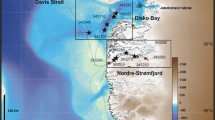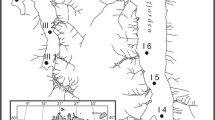Summary
Planktonic diatoms were sampled in the ice-edge zone of the Bellingshausen Sea during the early austral spring of 1990 and of the Weddell Sea during the late spring of 1983, the autumn of 1986, and the winter of 1988. The four cruises in the Antarctic marginal ice edge zones, combined with the summer cruise in Prydz Bay during a brief ice-free period (1988) provided us with opportunities for spatial and seasonal studies of diatom abundance and distribution in the water column. Cells from discrete water samples from 73 stations near the marginal ice-edge zones during all seasons were counted to gain quantitative information on the composition, abundance, and distribution of diatoms. Diatom abundance was dominated by the pennate diatom, usually nanoplanktonic, Fragilariopsis cylindrus (Grunow) Krieger, during all five cruises. The highest integrated numbers of F. cylindrus were found during the summer cruise with 7.9 × 1010 cells m−2 and the lowest numbers were found during the winter cruise with 1.1 × 108 cells m−2. The average integrated abundance of F. cylindrus from the five cruises was about 35% of the total diatom abundance. The overall spatial pattern of F. cylindrus near the marginal ice-edge zones during the five seasonal cruises were similar with the highest number of cells in open waters compared to ice-covered waters. When all 73 stations during the five cruises were included in the correlation analysis, the abundance of total diatoms was positively correlated with the abundance of F. cylindrus, suggesting that the ice-edge pulses of diatom assemblages in the water column largely reflected its abundance. Cluster analysis revealed that the stations in marginal ice-edge zones were not only separated by seasons and locations, but they also separated based on location of stations in relation to the ice edge (open water stations vs. ice-covered stations).
Similar content being viewed by others
References
Ackley SF (1985) Pressure ridge associated microbial communities in Antarctic sea ice. EOS 66:1278
Ainley DO, Fraser WR, Sullivan CW, Torres JJ, Hopkins TL, Smith WO Jr (1986) Antarctic mesopelagic micronekton: evidence from seabirds that pack ice affects community structure. Science 232:847–849
Buck KR, Garrison DL (1983) Protists from the ice-edge region of the Weddell Sea. Deep-Sea Res 30:1261–1277
Clarke DB, Ackley SF (1984) Sea ice structure and biological activity in the Antarctic marginal ice zone. J Geophys Res 89:2087–2095
Cota GF, Smith WO Jr (1989) Phytoplankton biomass and productivity in the marginal ice zone of the Weddell-Scotia Sea during austral winter. Antarct J US 24:152–153
Crumpton WG (1987) A simple and reliable method for making permanent mounts of phytoplankton for light and fluorescence microscopy. Limnol Oceanogr 32:1154–1159
El-Sayed SZ, Taguchi S (1981) Primary production and standing crop of phytoplankton along the ice-edge in the Weddell Sea. Deep-Sea Res 28:1017–1032
El-Sayed SZ, Weber LH (1982) Spatial and temporal variations in phytoplankton biomass and primary productivity in the south-west Atlantic and the Scotia Sea. Polar Biol 1:83–90
Fenner J, Schrader HJ, Wienigk H (1976) Diatom phytoplankton studies in the southern Pacific Ocean, composition and correlation to the antarctic convergence and its paleoceanographical significance. In: Hollister CD, Craddock, C (eds) Init Rept DSDP 25, Washington (US Govt Printing Office), pp 757–813
Frenguelli J, Orlando H (1958). Diatomeas y silicoflagelados del sector Antartico Su damericano. Inst. Antarct Argent 5:1–191
Fryxell GA (1986) Microalgae at the ice edge in the northern Weddell Sea. Antarct J US 21:166–168
Fryxell GA, Kendrick GA (1988) Austral spring microalgae across the Weddell Sea ice edge: spatial relationships found along a northward transect during AMBRIEZ 83. Deep-Sea Res 35:1–20
Fryxell GA, Kang S-H, Reap ME (1987) AMBRIEZ 1986; Phytoplankton at the Weddell Sea ice edge. Antarct J US 22:173–175
Fryxell GA, Kang S-H, Ashworth TK (1989) AMBRIEZ 1988 and ODP Leg 119: Antarctic phytoplankton summer and winter stage indicators. Antarct J US 24:156–157
Fryxell GA, Reap ME, Kang S-H (1988) Antarctic phytoplankton dominants, life stages, and indicators. Antarct J US 23:129–131
Garrison DL, Buck KR (1985) Sea-ice algal communities in the Weddell Sea: Species composition in ice and plankton assemblages. In: Gary JS, Christiansen ME (eds) Marine biology of polar regions and effects of stress on marine organisms. J Wiley, New York, pp 103–122
Garrison DL, Buck KR (1989a) Protozooplankton in the Weddell Sea, Antarctica: abundance and distribution in the ice-edge zone. Polar Biol 9:341–351
Garrison DL, Buck KR (1989b) The biota of Antarctic pack ice in the Weddell Sea and Antarctic peninsula regions. Polar Biol 10:211–219
Garrison DL, Sullivan CW, Ackley SF (1986) Sea ice microbial communities in Antarctica. BioScience 36:243–250
Garrison DL, Buck KR, Fryxell GA (1987) Algal assemblages in antarctic pack ice and in ice-edge plankton. J Phycol 23:564–572
Hallegraeff GM (1981) Seasonal study of phytoplankton pigments and species at a coastal station off Sydney: importance of diatoms and the nanoplankton. Mar Biol 61:107–118
Hannah FJ, Boney AD (1983) Nanophytoplankton in the Firth of Clyde, Scotland: seasonal abundance, carbon fixation and species composition. J Exp Mar Biol Ecol 67:105–147
Hasle GR (1965a) Nitzschia and Fragilariopsis species studied in the light and electron microscopes. II. The group Pseudonitzschia. Skr Nor Vidensk-Akad Olso 18:5–15
Hasle GR (1965b) Nitzschia and Fragilariopsis species in the light and electron microscopes. III. The genus Fragilariopsis. Skr Nor Vidensk-Akad Olso 21:5–49
Hasle GR (1969) An analysis of the phytoplankton of the Pacific Southern Ocean: abundance, composition, and distribution during the Brategg Expedition, 1947–1948. Hvaldradets Skr 52:1–168
Hasle GR (1972) Fragilariopsis Hustedt as a section of the genus Nitzschia Hassall. Beih Nov Hedw 54:15–66
Hasle GR (1978) The inverted microscope method. In: Sournia A (ed) Monographs on oceanic Methodology. 6. Phytoplankton manual. UNESCO, Paris, pp 88–96
Hempel G (1985) Antarctic marine food webs. In: Siegfried WR, Condy PR, Laws RM (eds) Antarctic nutrient cycles and food webs. Springer, Berlin, pp 226–270
Hewes CD, Reid FMH, Holm-Hansen O (1984) The quantitative analysis of nanoplankton: a study of methods. J Plankton Res 6:601–613
Husby DM, Muench RD, Gunn J (1989) Oceanographic observations in the Scotia Sea marginal ice zone June–August 1988. NOAA-TM-NMFS-SWFC-127
Hustedt F (1958) Diatomeen aus der Antarktis und dem Südatlantik. Dtsch Antarkt Exped 1938–39. Wiss Ergebn 2:103–191
Jouse AP, Koroleva GS, Nagaeva GA (1962): Diatomorrje Vodorosli v poverkhnostnom Sloe Donnykh Osadkov Indiiskogo Sketora Antarktiki. Trudy Inst Oceanol 61:19–92
Kang S-H (1989) Diatom species composition and abundance in water column assemblages from five drill sites in Prydz Bay, Antarctica, Ocean Drilling Program Leg 119: distributional patterns. MS thesis, Texas A and M University, College Station, Texas
Kang S-H (1992) Phytoplankton in the Antarctic marginal ice edge zones. PhD Diss, Texas A and M University, College Station, Texas
Kang S-H, Fryxell GA (1989) Comparative method of quantitative analysis of diatoms in water column assemblages in Prydz Bay, Antarctica, Ocean Drilling Program Leg 119. EOS 70:376
Kang S-H, Fryxell GA (1991) Most abundant diatom species in water column assemblages from five ODP Leg 119 drill sites in Prydz Bay, Antarctica: distributional patterns. In: Barron J, Larsen B (eds) Proc ODP Sci Res, 119. College Station, TX (Ocean Drilling Program), pp 645–666
Kang S-H, Fryxell GA, Roelke DL (1992) Fragilariopsis cylindrus (Grurow) Krieger compared with Antarctic Bacillariaceae in marginal ice edge zones. Beih Nov Hedw (in press)
Kozlova OG (1962) Specific composition of diatoms in the waters of the Indian sector of the Antarctic. Trudy Inst Oceanol 61:3–18
Malone TC (1980) Algal size. In: Moris I (ed) The physiological ecology of phytoplankton. Blackwell, London, pp 433–463
Manguin E (1960) Les diatomees de la Terre Adelie Campagne du “Commandant Charcot”, 1949–1950. Ann Sci Nat, Ser A 12:223–363
Medlin, I.K, Priddle J (1990) Polar marine diatoms. Br Antarct Surv, Nat Environ Res Coun, pp 1–214
Nelson DM, Smith WO Jr (1986) Phytoplankton bloom dynamics of the western Ross Sea ice edge. II. Mesoscale cycling of nitrogen and silicon. Deep-Sea Res 33:1389–1412
Nelson DM, Smith WO Jr, Gordon LI, Huber BA (1987) Spring distributions of density, nutrients, and phytoplankton biomass in the ice edge zone of the Weddell-Scotia Sea. J Geophys Res 92:7181–7190
Nelson DM, Smith WO Jr, Muench RD, Gordon LI, Sullivan CW, Husby DM (1989) Particulate matter and nutrient distributions in the ice-edge zone of the Weddell Sea: Relationship to hydrography during late summer. Deep-Sea Res 36:191–209
Pomeroy LR (1974) The ocean's food web, a changing paradigm. BioScience 24:499–504
Reid FMH (1983) Biomass estimate of components of the marine nanoplankton and picoplankton by the Utermöhl settling technique. J Plankton Res 5:235–252
Round FE, Crawford RM, Mann DG (1990) The Diatoms: Biology and morphology of the genera. Cambridge University Press, pp 1–747
Smith RC, Prézelin BB, Baker KS, Bidigare RR, Boucher NP, Coley T, Karentz D, MacIntyre S, Matlick HA, Menziez D, Ondrusek M, Wan Z, Waters KJ (1992) Ozone depletion: Ultraviolet radiation and phytoplankton biology in Antarctic waters. Science 255:952–959
Smith WO Jr (1987) Phytoplankton dynamics in marginal ice zones. Oceanogr Mar Biol Annu Rev 25:11–38
Smith WO Jr, Garrison DL (1990) Marine ecosystem research at the Weddell Sea ice edge: The AMERIEZ Program. Oceanography 3:22–29
Smith WO Jr, Nelson DM (1985) Phytoplankton bloom produced by a receding ice edge in the Ross Sea: Spatial coherence with the density field. Science 227:163–166
Smith WO Jr, Nelson DM (1986) Importance of ice edge phyto plankton production in the Southern Ocean. BioScience 36:251–257
Smith WO Jr, Nelson DM (1990) Phytoplankton growth and new production in the Weddell Sea marginal ice zone in the austral spring and autumn. Limnol Oceanogr 35:809–821
Sommer U (1989) Maximal growth rates of Antarctic phytoplankton: Only weak dependence on cell size. Limnol Oceanogr 34:1109–1112
Sullivan CW, Ainley DG (1987) AMERIEZ 1986: A summary of activities on board the R/V Melville and USCGC Glacier. Antarct J US 22:167–169
Sullivan CW, McClain CR, Comiso JC, Smith WO Jr (1988) Phytoplankton standing crops within an Antarctic ice edge assessed by satellite remote sensing. J Geophys Res 93:12,487–12,498
Sullivan CW, Cota GF, Krempin DW, Smith WO Jr (1990) Distribution and activity of bacterioplankton in the marginal ice zone of the Weddell-Scotia Sea during austral spring. Mar Ecol Prog Ser 63:239–252
Utermöhl H (1958) Zur Vervollkommnung der quantitative Phytoplankton-Methodik. Mitt Int Verh Theor Angew Limnol Ver 9:38
Weber LH, El-Sayed SZ (1987) Contributions of the net, nano- and picoplankton to the phytoplankton standing crop and primary productivity in the Southern Ocean. J Plankton Res 9:973–994
Wilson DL, Smith WO Jr, Nelson DM (1986) Phytoplankton bloom dynamics of the western Ross Sea ice edge. I. Primary productivity and species-specific production. Deep-Sea Res 33:1375–1378
Zwally HJ, Comisco JC, Parkinson CL, Campbell WJ, Carsey FD, Gloersen P (1983) Antarctic sea ice, 1973–1976: Satellite passive-microwave observations, NASA SP-459, US Government Printing Office, Washington DC, 206 pp
Author information
Authors and Affiliations
Rights and permissions
About this article
Cite this article
Kang, SH., Fryxell, G.A. Fragilariopsis cylindrus (Grunow) Krieger: The most abundant diatom in water column assemblages of Antarctic marginal ice-edge zones. Polar Biol 12, 609–627 (1992). https://doi.org/10.1007/BF00236984
Received:
Accepted:
Issue Date:
DOI: https://doi.org/10.1007/BF00236984




